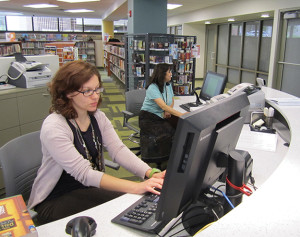No librarian is an island, and nowhere was that more evident than at the 2012 ALSC National Institute held September 20–22 in Indianapolis. Hundreds of youth librarians from across the country gathered for three days of networking, sharing ideas, and learning from and teaching each other. I sat down with librarians after the very first session and it was evident what the theme of the conference would be for me: purposefulness. Over and over again, presenters stressed the importance of thinking critically about the programs and services we’re offering and presenting them with purpose.
In one breakout session, Celia Huffman of Cuyahoga County (Ohio) Public Library addressed “Planning for Excellence” and urged librarians to determine goals and priorities based on community needs. It’s not enough to offer programs for children. By looking first at community needs and research in child development, we can better design programs and services that will make a difference in our communities. Sarah Mackie of the Columbus (Ohio) Metropolitan Library demonstrated how her library responded to community needs in the face of falling scores on a kindergarten readiness assessment. The library established the Ready to Read Corps, a dedicated department of early literacy experts who take to the streets to educate parents about early literacy.
A session by Lori Romero and Melissa Depper of the Arapahoe County (Colo.) Library District reinforced the idea of turning to early literacy and child development research when planning programs for young children. Lori and Melissa shared materials they had developed to train and evaluate storytime providers throughout their branches. Top on their list of priorities is including early literacy messages to parents and using activities that are thoughtfully planned to develop early literacy skills.
Before librarians can share messages about early literacy, we must be trained. A panel of librarians spoke about just that in a session entitled “What Difference Does it Make? The Impact of Early Literacy Training on Youth Services Staff.” Sharon Grover and Julie Westby of the Hedberg Public Library in Janesville, Wisconsin, shared their journey as Betsy Diamant-Cohen and Saroj Ghoting held workshops for Hedberg’s library staff. Allison Kaplan of the University of Wisconsin–Madison told how she helped the staff of the Hedberg Library develop surveys to evaluate whether the training had had an impact on staff and the services offered at the library.
Librarians danced, boogied, and sang along to an interactive presentation by Kate Schiavi, who talked about the preschool dance parties she offers as part of the programming at Louisville (Ky.) Free Public Library. Although children are wired from birth to learn music, their musicality needs to be nurtured or it will begin to diminish. Singing is one of the five early literacy activities outlined in Every Child Ready to Read 2.0 because it helps develop phonological awareness and fluency.
Of course, there was also time throughout the institute to connect with other youth librarians and share ideas in an informal setting. There was much talk around dinner tables about programs being offered, favorite books read, and useful resources for training staff. Just as the institute allowed youth services specialists to come together and network, it also enabled librarians to connect with some of their favorite authors. Peter Brown, author of several bestselling picture books, spoke about his writing and illustrating process. Denise Fleming, Kevin Henkes, and Eric Rohmann spoke on a panel of Caldecott Medal and Honor winners to kick off the 75th anniversary of the Caldecott Medal. Paulsen had the room in tears and in stitches as he recounted some of his adventures and told about a librarian who turned his life around by offering him a library card at age 13. And we closed out the institute with a panel of nonfiction authors and illustrators. Doreen Rappaport, April Pulley Sayre, and Bryan Collier spoke about research and making connections with their audiences to bring facts to life.
Throughout the institute, I kept coming back to the idea of purpose. Session after session challenged me to think about why I’m offering the programs and services I do, what outcomes I’m hoping for, and how to measure results. Take a look at your programs and services and ask yourself why you’re offering them. If your answer is “Because they’re fun” or “Because our patrons expect them,” you might consider thinking a bit deeper.
Asking yourself “why” is not an easy task. It requires shining a bright light on your programs and services to honestly assess whether they’re working. If not, how can you rearrange your department, reallocate funds, retrain your staff, or refocus your energy? Library programs can help young children get ready to start school as well as imbue students with some of the 40 developmental assets they need to succeed in life. Our programs can change our communities, but only if we start by thinking critically about the activities we’re offering, design programs with results in mind, and evaluate what we’ve done to see how it can be improved.
ABBY JOHNSON is children’s services/outreach manager at New Albany–Floyd County (Ind.) Public Library. Find her at abbythelibrarian.com.

